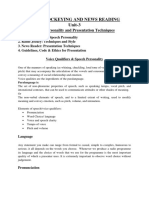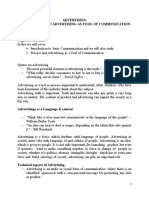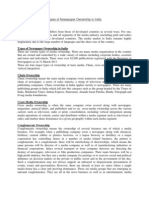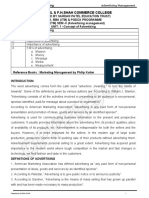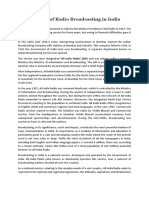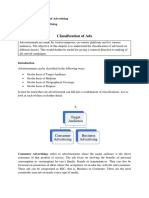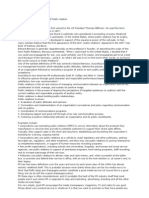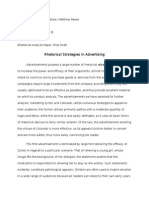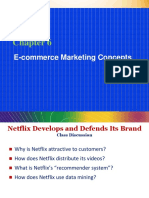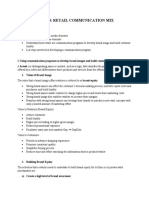Aaai & Asci
Aaai & Asci
Uploaded by
Hiral PandhiCopyright:
Available Formats
Aaai & Asci
Aaai & Asci
Uploaded by
Hiral PandhiOriginal Title
Copyright
Available Formats
Share this document
Did you find this document useful?
Is this content inappropriate?
Copyright:
Available Formats
Aaai & Asci
Aaai & Asci
Uploaded by
Hiral PandhiCopyright:
Available Formats
AAAI
INTRODUCTION On September 21, 1945, 60 years ago, Advertising Agencies Association of India (AAAI) was registered as a society in Calcutta. 4 agencies from Calcutta D J Keymer, General Advertising Agency, J Walter Thomson Co. and Press Syndicate and 3 agencies from Bombay Adarts, Lintas and National Advertising Service were the signatories in the registrars office doing the honours. Initially the registered office of the Association was located at 37, Chowringhee, Calcutta. Calcutta, under the British Raj, was a vibrant commercial city. In 1961, the AAAI office was shifted to Bombay. What was the size of the ad industry then? The Governments own Press Commission in 1953 noted that the value of print advertising was Rs. 35 million. Other media spends were estimated at another Rs. 15 million. In such an era, these were some real bold men, who felt the need to create a platform to promote advertising, as a professional activity! In summary, AAAI, over the last six decades, has stood by its members and have protected their business interests, be it in dialogue with Government, media bodies or advertisers; AAAI has regulated its members in the orderly conduct of their business affairs, whenever the need arose; And last, but not the least, AAAI provided a platform for training of advertising professionals, recognition of creative work through its coveted Triple-A Awards and honouring outstanding advertising men through its AAAIPremnarayen Award. AAAI has thus come a long way from its humble beginnings 60 years ago. But as they say, the future is always more exciting than the past. AAAI is alive to the changes that the future holds out and the next decade would be a stimulating period, ushering the advertising industry in newer challenges and opportunities. OBJECTIVES The Advertising Agencies Association of India (AAAI) is the official, national organization of advertising agencies, formed to promote their interests so that they continue to make an essential and everincreasing contribution to the nation, by working towards the following objectives: To benefit Indian consumers and to protect their interests by helping ensure that advertising is honest and in good taste. To benefit Indian advertisers by promoting their sales, increasing their sales and increasing productivity & profitability, to stimulate business and industrial activity. To benefit media by establishing sound business practices between advertisers and advertising agencies and each of the various media owners. To benefit the nation by harnessing advertising for the good of the country, its institutions, its citizens; to co-operate with the Government in promoting its social objectives and in the task of nation-building. To question advertising that is wasteful and extravagant; to make it possible for the small entrepreneur to grow through advertising and to compete with the biggest; to encourage market and media research; to serve society by meeting its social responsibilities. To encourage the interest of young individuals in the business of communication, to assist in education and training programmes and to provide information of benefit to members. Non-members are also provided this service for a fee. To establish a common platform in building and sustaining the prestige of the advertising profession and to serve as a spokesman against unwarranted attacks or restrictions on advertising.
To establish a forum where representatives of advertisers, advertising agencies, media owners and Government can meet on mutual ground and examine problems of mutual concern. To offer effective co-operation and liaison with Government officials and bodies for the purpose of broadening their understanding of the role of advertisers, advertising and advertising agencies. To co-operate with Government bodies in discussion of matters such as taxes, radio and TV advertising, legislation, political campaign advertising, controls on pharmaceuticals, tobacco or liquor advertising and other subjects of similar complexity and sensitivity. The AAAI today is truly representative, with a very large number of small, medium and large-sized agencies as its members, who together account for almost 80% of the advertising business placed in the country. It is thus recognized at all forums -- advertisers, media owners and associations, and even Government -- as the spokesperson for the advertising industry. FUNCTIONS The AAAI functions through the active, voluntary services of a President, a Vice-President, an Honorary Secretary, an Honorary Treasurer and an Executive Committee assisted by a full-time Secretary-General and his staff. The Association maintains a permanent office, which is located at: 35 Maker Tower 'F', 3rd Floor, Cuffe Parade, Mumbai 400 005. Conventionally, a very senior agency person represents each member agency in the AAAI. The President and other office-bearers are elected every year by the General Body, which comprises all representatives of member agencies. In addition, some Executive Committee Members are co-opted to the Executive Committee and an effort is made to ensure that all zones and groups of agencies (by size) are represented on this Committee. Assisting the above groups are various Sub-committees, each looking after specific activity areas of the Association, and Regional Conveners who co-ordinate members' activities in different regions of the Country. The Executive Committee, the Regional Conveners and various Sub-Committees meet very regularly and information is constantly shared with all members. The AAAI is thus a true association, in the sense that nearly half of all members are directly involved with one or more of the active committee groups and the remaining members are in touch through direct communication.
ASCI
INTRODUCTION Advertising Standards Council of India is a self regulatory voluntary organization of the advertising industry. The Advertising Standards Council of India (ASCI), established in 1985, is committed to the cause of SelfRegulation in Advertising, ensuring the protection of the interests of consumers. The ASCI was formed with the support of all four sectors connected with Advertising, viz. Advertisers, Ad Agencies, Media (including Broadcasters and the Press) and others like PR Agencies, Market Research Companies etc. Its
main objective is to promote responsible advertising thus enhancing the public's confidence in Advertising. ASCI is represented in all committees working on advertising content in every Ministry of the Government of India. ASCIs Code for Self-Regulation in Advertising is now part of ad code under Cable TV Acts Rules. Violation of ASCIs Code is now violation of Govt. rules. ASCIs membership of The European Advertising Standards Alliance (EASA) ensures that it gets valuable advice, learning and even influence at the international level. The Consumer Complaints Council is ASCI's heart and soul. It is the dedicated work put in by this group of highly respected people that has given tremendous impetus to the work of ASCI and the movement of self-regulation in the advertising. This group comprise of 21 drawn from various disciplines. 12 are eminent people not associated with advertising ( such as lawyer, doctor, journalist, teachers, technical experts consumer activities etc.) and 9 are from industry (advertiser, media, ad agencies and allied professionals. ASCI thus aims to achieve its own overarching goal: to maintain and enhance the public's confidence in advertising. ORGANISATION: The Board of Governors (16 members) ensures equitable representation of Advertisers, Agencies, Media and other Advertising Services, the individual member firms being leaders in their respective industries or services. The Consumer Complaints Council (CCC) (21 members) has 12 Non-Advertising professionals representing civil society, who are eminent and recognised opinion leaders in their respective disciplines such as Medical, Legal, Industrial Design, Engineering, Chemical Technology, Human Resources and Consumer Interest Groups; 9 are advertising practitioners from our member firms. The ASCI code of Advertising Practice is mentioned in 4 Chapters: Chapter 1: To ensure truthfulness and honesty of representations and Claims made. Chapter 2: To ensure advertisement is not offensive to generally acceptable standard of Public Decency. Chapter 3: To safeguard against indiscriminate advertisement in situation or of the promotion of products which are regarded as hazardous or harmful to society or to individuals particularly minors. Chapter 4: To ensure that advertisement observes fairness in competition: Chapter 1 Advertisement should be truthful. All descriptions, claims and comparisons, which relate to matters of objectively ascertainable fact, should be capable of substantiation. Advertisement claims expressly stated based on or supported by independent research or assessment, the source and date of this should be indicated in the advertisement. Advertisement involving brand ambassadors should have exclusive agreements with them. Advertisement shall not distort facts; mislead the consumer by means of implicit omissions. Advertisement shall not be framed to abuse the trust of the consumers or exploit their knowledge, by their lack of experience. Products described Free shall clearly state what is free and what is not- no hidden cost.
Product offered free on purchase of another product should be of same quality unless specifically stated. Claims Up to 5 years, or Price as low as are not acceptable if there is a likelihood of being consumer being mislead either to the extent of their availability or applicability. Special care or restraint to be exercised in advertisement addressed to those who is suffering from weakness, or any physical inadequacy. Advertisement inviting public to invest money shall contain reference to read Risk Clauses. Advertisement inviting public to participate in lotteries or prize competition permitted under the law shall specify all the terms viz Tax Deductions at Source, The Government Sponsored/Authorized schemes, terms and conditions of the contest etc.
In the case of Mass manufacture of products and services occasional unintentional lapse are permitted in fulfillment of an advertised promise or claim, if the defect falls within generally accepted limits of Quality Control, and the advertiser has taken prompt action to make good the deficiency.
Chapter 3
To safeguard against indiscriminate use of advertising in situation of the promotion of product, which are regarded as hazardous or harmful to society or to individuals, particularly minors, to a degree or a type, which is unacceptable to society at large.
No advertisement shall be permitted which: Tend to incite people to crime or to promote disorder and violence or intolerance. Derides any race, caste, color, creed, or nationality. Presents criminality as desirable or directly or indirectly encourages people, particularly children, to emulate it or convey the modus operandi of any crime. Advertisement affects friendly relations with foreign State. Advertisements addressed to minors shall not contain anything, whether in illustration or otherwise, which might result in their physical, mental or moral harm or which exploits their vulnerability. Should not encourage minors to enter strange places Should not feature dangerous or hazardous acts, which are likely to encourage minors to emulate such acts, which could cause harm or injury. Should not show minors playing with inflammable or explosive substances. Should not feature minors for tobacco or alcohol based products.
Advertisement should contain nothing, which is in breach of law, nor omit anything, which the law requires.
Advertisement shall not propagate products, which are banned under the law.
Advertisement for products whose advertisement is banned or restricted by law or by this code must not circumvent such restrictions by purporting to be advertisement for other products. Chapter 4 To ensure that the advertisement observes fairness in competition such that the consumers need to be informed on choice in the market place.
Advertisement containing comparison with other manufacturers or suppliers or with other products including those where a competitor is named, are permissible in the interest of vigorous competition and public enlightenment provided: It Is clear which aspects of the advertisers product has been compared with what aspects of competitors product The subject matter of comparison is not chosen in such a way as to confer an artificial advantage upon the advertiser or so as to suggest that a better bargain is offered than is truly the case. The comparison are factual, accurate and capable of substantiation There is a likelihood of the consumer being mislead as a result of the comparison, whether about the product advertised or that with which it is compared. The advertisement does not unfairly denigrate attack or discredit other products, advertisers or advertisement directly by implication.
Advertisement shall not make unjustifiable use of names, initials of the other firm, company or institution, nor take unfair advantage of the goodwill attached to the Trade Mark or symbol of other firms. Advertisement shall not be similar to any other advertisers earlier run advertisement in general lay out, copy, slogans, visual representation, music or sound effects, so as to suggest plagiarism . FUNCTIONS The Role and Functioning of the ASCI & its Consumer Complaints Council (CCC) in dealing with Complaints received from Consumers and Industry, against Ads which are considered as False, Misleading, Indecent, Illegal, leading to Unsafe practices, or Unfair to competition, and consequently in contravention of the ASCI Code for Self-Regulation in Advertising. ASCI are a voluntary self-regulatory council, registered as a not-for-profit Company under section 25 of the Indian Cos. Act. The sponsors of the ASCI, who are its principal members, are firms of considerable repute within Industry in India, and comprise Advertisers, Media, Ad. Agencies and other Professional /Ancillary services connected with advertising practice.
The ASCI is not a Government body, nor does it formulate rules for the public or for the relevant industries. The Purpose and the Mission of the ASCI is spelt out clearly in the literature provided. You will appreciate that if an AD is to be reviewed for its likely impact on the sensibilities of individual viewers of TV, or readers of press publications, we require to convey to the Advertiser concerned, the substantial issues raised in the complaint, in the exact context of the specific Ad, as conveyed by the perception of the complainant, and to elicit the appropriate response by way of comments from the Advertiser. Only then will the CCC, of the ASCI, be in a position to deliberate meaningfully on the issues involved, and to arrive at a fair and objective conclusion, which would stand the scrutiny of all concerned with the right to freedom of expression, and the freedom of consumers to choose the products /services made available to them in the market-place. For this we require in each case a clearly readable copy or clipping of the Ad under complaint, with full particulars of name and date of publication, or a printout of an Ad or promotion on a Website or in case of a T.V. Commercial, the channel, date and time or programme of airing, and a description of the contents of the TVC, along with a hard copy of the complete complaint preferably signed by the complainant. As a policy we do not disclose the identity of the complainant to the Advertiser. The ASCI receives and processes complaints against Ads, from a cross section of consumers, the general public and Industry, in the interests of all those who rely on advertising as a commercial communication, and this covers individuals, practitioners in advertising, advertiser firms, media, ad. agencies, and ancillary services connected with advertising. In the case of complaints which were Upheld by the CCC, during the past year, it may interest you to know that over 80% of such Ads have been withdrawn or modified appropriately by the Advertisers/Agencies involved, and the concerned Media have also confirmed that they would not carry such offending Ads/TVC. Secretary General POWER ASCI's role has been acclaimed by various agencies including the Government. However, it lacked the force of legal recognition. The Government of India has at last, taken note of this and by one stroke on 2nd August 2006 vide a notification in The Gazette of India: Extraordinary {Part II sec. 3(i)}, made sure that at least as far as TV Commercials go, they abide by the ASCI code. The amendment made in Cable Television Networks Rules, 1994 through a Notification dated August 2nd, 2006 now states: " (9) No advertisement which violates the Code for Self-Regulation in Advertising, as adopted by the Advertising Standards Council of India (ASCI), Mumbai for public exhibition in India, from time to time, shall be carried in the cable service".
REPORT OF CONSUMER COMPLAINTS COUNCIL (CCC)
COMPLAINTS THAT WERE UPHELD BY THE CCC From April 2009 to March 2010
Sr. No.
Advertiser / Agency / Media
Claim / Description of Ad/ TVC
Complaint
ASCI Code/ CCC Decision
# Intra-Industry Complaints * ASCI Member $ Complaint received from Consumer Representational Organisation
Advertisements Modified Appropriately / Withdrawn / Concluded
1.
Videocon Industries Ltd (Videocon Washing Machines)
Claims - Eco-Friendly washing machines, Designed to not just care for your clothes, but also conserve water, save energy.
(Complaint received in 2/2009) Advertiser should substantiate the claims on the basis of technical data for water consumption as well as energy saving. How does the product qualify to be eco-friendly?
April 2009 Chapter I.1. Claims not substantiated.
Saatchi & Saatchi(*)
Ad withdrawn.
Business India(*) (2/2009 issue)
2.
Go Airlines (India) Pvt Ltd (Free Flight Offer)
Ad offer - 1 free ticket for every 5 flights taken on GoAir flights, all flights to be taken before March 31, 2009.
(Complaint received in 5/2009) This offer was not made good to the Complainant.
June 2009 Chapter I.4. Claim/offer made on the Advertisers website was misleading
Ad on website
Advertiser assured that they have made good the offer to the Complainant.
3.
Bajaj Auto Ltd(*) (Bajaj XCD Motorbike)
TVC shows the rider of the bike driving at a very high speed and at a dangerous angle from the earth.
(Complaint received in 5/2009) Ad is dangerous.
June 2009 Clause C of the Guidelines on Advertisements for Automotive Vehicles. Cautionary message in the TVC was inadequately readable. TVC has been modified appropriately by increasing the size of the cautionary message. Advertiser assured that the said TVC will not be aired in future.
O & M(*)
TVC aired on various channels
4.
Hero Honda Motors Ltd(*) (Hero Honda Motorbike) Draft FCB-Ulka(*) TVC aired on
TVC shows - a film star riding on Hero Honda Motorbike and is driving a helicopter on a very high surface.
(Complaint received in 5/2009) Ad is dangerous.
June 2009 Clause C of the Guidelines on Advertisements for Automotive Vehicles. Cautionary
various channels
message in the TVC was inadequately readable. Advertiser assured appropriate modification of the TVC.
5.
Hyundai Motor India Ltd (Hyundai Verna)
Ad headline - Leave the city behind, with the Hyundai Verna
(Complaint received in 5/2009) Headline is similar to the headline copy created and released for Ford Fiesta Fiesta leaves the city far behind. The blatant use of the copy by Hyundai Verna will confuse and dilute Ford Fiestas communication recall.
June 2009 Chapter IV.3. Headline copy of the Advertisers Ad was similar to that of the headline copy of the Complainants Ad. Ad released by the local dealer has been withdrawn.
Deccan Chronicle(*) (5/2009)
6.
Idea Cellular Ltd (Idea)
Lowe Lintas(*)
NDTV Imagine(*) (7/2009)
TVC shows - people from different professions on various locations and situations walking and talking on mobile, two men carrying a huge hoarding, climbing stair case, walking on the pavement, etc.
(Complaint received in 7/2009) TVC encourages an unsafe act of walking while talking on the mobile phone, which could cause injury to a person or others or both.
July 2009 Chapter III.3. Some action sequences as depicted in the TVC, shows dangerous practices and manifest a disregard for safety without justifiable reason.
(Seven similar complaints received against the same TVC).
TVC modified.
7. Reliance Communications Ltd(*) (Reliance Netconnect Broadband)
Claim Reliance is the fastest mobile broadband service in India
(Complaint received in 9/2009) Advertiser claims to be the fastest mobile broadband service in India, without specifying the maximum/minimum speed. Advertiser should specify the minimum speed as per TRAI rules.
September 2009 Chapter I.1. Claim was not substantiated with comparative data of other mobile services. TVC suspended. Advertiser assured appropriate modification of the TVC.
Tribal DDB India AXN(*) (8/2009)
8.
T. I. M. E. (Coaching for CAT for IIM Entrance)
#
The Times of India(*) (6/2009)
Claims - Indias No.1 CAT training Institute is now No.1 in DelhiNCR, 1000* T.I.M.E. students have gained final admission into the IIMs in CAT08.
(Complaint received in 7/2009) Advertiser has failed to disclose the parameters on which it has claimed to be No.1 in India as well as in Delhi/NCR. Advertiser needs to submit the parameters taken into account while deciding whether a student who got admitted in any IIM is actually their student or not. Also they should submit the data of 1000 NCR/Delhi students along with their course details.
September 2009 Chapter I.1. Claim, Indias No.1 CAT training institute, not substantiated with comparative data of other institutes.
Subsequently, the Advertiser provided proof in substantiation of the said claim.
You might also like
- Organizational Structure of A TV News ChannelDocument17 pagesOrganizational Structure of A TV News ChannelAmit Kumar69% (13)
- Print Journalism BJMC NotesDocument51 pagesPrint Journalism BJMC Notesxyz_17127476795% (20)
- Advertising 4TH SemDocument16 pagesAdvertising 4TH Semxyz_17127476750% (8)
- Public Relations Ba (JMC) NotesDocument52 pagesPublic Relations Ba (JMC) Notesxyz_17127476791% (11)
- Classification of AdvertisingDocument9 pagesClassification of Advertisingutcm77100% (4)
- Radio Jockeying and News Reading Unit-3: Voice Personality and Presentation TechniquesDocument6 pagesRadio Jockeying and News Reading Unit-3: Voice Personality and Presentation TechniquesDhruv S100% (1)
- Prog Copywriting 01 PDFDocument66 pagesProg Copywriting 01 PDFEduardo Alvarez Mendizabal100% (3)
- RJNR Unit 4Document35 pagesRJNR Unit 4Dhruv S100% (2)
- The Nitesh Sengupta Committee Report On Prasar BharatiDocument31 pagesThe Nitesh Sengupta Committee Report On Prasar BharatiVipul Partap0% (1)
- Joshi Committee and Bachhawat CommitteeDocument4 pagesJoshi Committee and Bachhawat Committeem tvl80% (5)
- Advertising Process and ParticipantsDocument12 pagesAdvertising Process and ParticipantsV A100% (1)
- Archives of American Art JournalDocument65 pagesArchives of American Art JournalVinit Gupta100% (1)
- Re Launch of Tapal FinalDocument26 pagesRe Launch of Tapal FinalMAllick TanveerNo ratings yet
- Advertising Agencies Association of IndiaDocument3 pagesAdvertising Agencies Association of IndiaChristina JohnsonNo ratings yet
- AAAIDocument19 pagesAAAIAshish ChughNo ratings yet
- Unit-IV Media Measurement ToolsDocument3 pagesUnit-IV Media Measurement ToolsJatin VermaNo ratings yet
- Corporate Communication Notes Unit 2Document8 pagesCorporate Communication Notes Unit 2Shubhangi0% (1)
- 1 Advertising 8 Lectures Topics 1 2 2 1 1 1Document16 pages1 Advertising 8 Lectures Topics 1 2 2 1 1 1SagarNo ratings yet
- Barc, Wam, RamDocument3 pagesBarc, Wam, RamJatin Verma100% (2)
- Basics of Advertising 202Document81 pagesBasics of Advertising 202Lavanya AggarwalNo ratings yet
- Alternative Paradigms: Participatory, Think Local/act Global - Think Global/act LocalDocument5 pagesAlternative Paradigms: Participatory, Think Local/act Global - Think Global/act LocalSuraj Shah100% (1)
- BOA - Unit 2 - Creativity in AdvertisingDocument6 pagesBOA - Unit 2 - Creativity in AdvertisingAnjali NolkhaNo ratings yet
- Magic Multiplier & Empathy Magic Multiplier & EmpathyDocument9 pagesMagic Multiplier & Empathy Magic Multiplier & EmpathyjjhjhjNo ratings yet
- Social Change Campaign - Case StudiesDocument4 pagesSocial Change Campaign - Case StudiesAnusha SawhneyNo ratings yet
- TRADITIONAL JOURNALISM Vs PENLESS JOURNALISM UPLOAD PDFDocument2 pagesTRADITIONAL JOURNALISM Vs PENLESS JOURNALISM UPLOAD PDFPushkar AnandNo ratings yet
- Radio Broadcasting in India Pre and Post IndependenceDocument7 pagesRadio Broadcasting in India Pre and Post IndependenceAkshat BhatlaNo ratings yet
- Introduction To House JournalDocument5 pagesIntroduction To House JournalHarsha Pursnani67% (3)
- Kheda and Jhabua Site ProjectDocument2 pagesKheda and Jhabua Site ProjectSHUBHANGI CHOWDHURY100% (2)
- Event Management Unit-1 PDFDocument28 pagesEvent Management Unit-1 PDFHardik SNo ratings yet
- Advertising As Tool of CommunicationDocument10 pagesAdvertising As Tool of Communicationruchi goelNo ratings yet
- Non-Linear: World System Theory, Neo Marxist Theory: Yashasvika YadavDocument15 pagesNon-Linear: World System Theory, Neo Marxist Theory: Yashasvika YadavGauri GargNo ratings yet
- Corporate Communication Notes Unit 1Document12 pagesCorporate Communication Notes Unit 1ShubhangiNo ratings yet
- Recommendations of MacBride CommissionDocument25 pagesRecommendations of MacBride CommissionDEEPAK GROVER83% (42)
- History of Advertising in IndiaDocument33 pagesHistory of Advertising in IndiaShivlal Yadav100% (5)
- Corporate Communication UNIT 4Document21 pagesCorporate Communication UNIT 4xyz_171274767100% (1)
- The Nature and Ideological Contours of Indian EconomyDocument3 pagesThe Nature and Ideological Contours of Indian EconomyStage Of ComedyNo ratings yet
- Magic MultiplierDocument5 pagesMagic MultiplierGauri Garg100% (1)
- Event Management Notes - Semester 5 - BA (JMC) - IP UniversityDocument109 pagesEvent Management Notes - Semester 5 - BA (JMC) - IP UniversityAadarsh Pandey0% (1)
- Role of Advertising in Marketing MixDocument6 pagesRole of Advertising in Marketing MixAshutosh Agrahari0% (1)
- SLM Media PDFDocument155 pagesSLM Media PDFVishal MalikNo ratings yet
- Types of Newspaper Ownership in IndiaDocument3 pagesTypes of Newspaper Ownership in IndiaShubham Nag96% (25)
- Advertisement ManagementDocument18 pagesAdvertisement ManagementashokdgaurNo ratings yet
- Advertising Management and Sales Promotion - Sbaa7010Document163 pagesAdvertising Management and Sales Promotion - Sbaa7010Pongsiri KamkankaewNo ratings yet
- Brief History of Radio Broadcasting in IndiaDocument2 pagesBrief History of Radio Broadcasting in IndiaArnab Mondal100% (1)
- Topic-3 Types of RadioDocument11 pagesTopic-3 Types of RadioDhruv S100% (3)
- UNIT 1 Anchoring-3Document52 pagesUNIT 1 Anchoring-3Suraj ShahNo ratings yet
- BOA - Unit 1 - Classification of AdsDocument4 pagesBOA - Unit 1 - Classification of AdsAnjali NolkhaNo ratings yet
- RJNR AssigmentDocument19 pagesRJNR AssigmentSaksham Jain100% (2)
- First Press CommissionDocument4 pagesFirst Press CommissionVanalika Kapoor70% (10)
- DAGMAR ApproachDocument2 pagesDAGMAR Approachrakshit123100% (3)
- Growth and Development of Online Journalism in IndiaDocument8 pagesGrowth and Development of Online Journalism in IndiaGourav Vishwakarma100% (2)
- Advertisement and Media Management NotesDocument103 pagesAdvertisement and Media Management NotesKUSUMA A100% (1)
- BOA - Unit 1 - Definition & FunctionsDocument4 pagesBOA - Unit 1 - Definition & FunctionsAnjali NolkhaNo ratings yet
- Unit 3 Corporate CommunicationDocument20 pagesUnit 3 Corporate Communicationxyz_171274767100% (1)
- Structure & Functions of Various Department of Newspaper Organization JournoGyanDocument8 pagesStructure & Functions of Various Department of Newspaper Organization JournoGyanriniNo ratings yet
- PR Unit - 1 NotesDocument16 pagesPR Unit - 1 NotesrajeeevaNo ratings yet
- Nature & Scope of PRDocument5 pagesNature & Scope of PRHurshVFadia100% (3)
- RJing Unit 1 SLMDocument23 pagesRJing Unit 1 SLMRachit Magoo100% (1)
- 6th Semester Notes Mme Unit 3 & 4Document8 pages6th Semester Notes Mme Unit 3 & 4Twinkle Sanoriya100% (1)
- Mcom Sem 4 Advertising NotesDocument100 pagesMcom Sem 4 Advertising Notesprathamesh gadgilNo ratings yet
- Aaai ND AsciDocument10 pagesAaai ND AscianmolNo ratings yet
- The Advertising Standards Council of IndiaDocument2 pagesThe Advertising Standards Council of IndiaAditya ShindeNo ratings yet
- UNIT 1 Topic 4Document8 pagesUNIT 1 Topic 4Radhika MalikNo ratings yet
- Customers Perception Towards SOTC Tours & TravelsDocument68 pagesCustomers Perception Towards SOTC Tours & TravelsAshish Tagade83% (6)
- Australian Lamb - Make Lamb, Not Walls - 835 Words - Essay ExampleDocument2 pagesAustralian Lamb - Make Lamb, Not Walls - 835 Words - Essay ExampleevansNo ratings yet
- BrandsDocument6 pagesBrandsNidhi ThakurNo ratings yet
- Couponing Weekly - Sample IssueDocument8 pagesCouponing Weekly - Sample IssueCouponing WeeklyNo ratings yet
- Rhetorical Analysis Paper, Final DraftDocument4 pagesRhetorical Analysis Paper, Final Draftapi-286438807No ratings yet
- TY-BBA-2015 - Syllabus PDFDocument60 pagesTY-BBA-2015 - Syllabus PDFATULNo ratings yet
- Professional CV ResumeDocument1 pageProfessional CV ResumeMame Fatima NdiayeNo ratings yet
- PARADE To Answer Resume QuestionsDocument8 pagesPARADE To Answer Resume QuestionsRobin LuoNo ratings yet
- LIFEBUOYDocument12 pagesLIFEBUOYBobyNo ratings yet
- Marketing BrochureDocument7 pagesMarketing BrochureArpit GulhaneNo ratings yet
- Complete Assignment - Docx (Final)Document15 pagesComplete Assignment - Docx (Final)anmeannNo ratings yet
- Abdul Wali M!!Document72 pagesAbdul Wali M!!Faisal AwanNo ratings yet
- There Are Six Basic Elements in Promotion Mix and Toilet Soap Industries Can Use Those Elements To Promote Their BrandsDocument7 pagesThere Are Six Basic Elements in Promotion Mix and Toilet Soap Industries Can Use Those Elements To Promote Their BrandsdhivagarNo ratings yet
- 6 Types of Branding You Should Know.Document3 pages6 Types of Branding You Should Know.KishanNo ratings yet
- Media Planning Notes Module 4Document9 pagesMedia Planning Notes Module 4Shadow hackerNo ratings yet
- Fourth Grade - Study Guide For English Exam - 1ST Period-2020Document7 pagesFourth Grade - Study Guide For English Exam - 1ST Period-2020joel montoyaNo ratings yet
- CHOOZLE - Location-Based Targeting Overview 2022Document2 pagesCHOOZLE - Location-Based Targeting Overview 2022Ryan AffolterNo ratings yet
- Soal TPM Kemitraan 1Document16 pagesSoal TPM Kemitraan 1ZafranZiyadNo ratings yet
- Full Project On SunsilkDocument27 pagesFull Project On Sunsilkmanu89% (9)
- Test Paper 1 - MarketingDocument5 pagesTest Paper 1 - MarketingAbhijit DasNo ratings yet
- Motivation, Personality and Emotion: Mochamad Malik Akbar RohandiDocument24 pagesMotivation, Personality and Emotion: Mochamad Malik Akbar RohandiAkmal DhafinNo ratings yet
- E-Commerce Marketing Concepts: Slide 6-1Document37 pagesE-Commerce Marketing Concepts: Slide 6-1Xuân LộcNo ratings yet
- CPALead Optimization GuideDocument12 pagesCPALead Optimization Guideergrull0No ratings yet
- Retail Chap10Document9 pagesRetail Chap10Phương ThảoNo ratings yet
- Application Form Submitted Successfully ConfirmationDocument2 pagesApplication Form Submitted Successfully Confirmationchemistry WorldNo ratings yet
- DaedalusR 0100dec US prf7Document26 pagesDaedalusR 0100dec US prf7jenghiskhanNo ratings yet
- The Evolution of Private Label BrandingDocument11 pagesThe Evolution of Private Label Branding101dalmatiansNo ratings yet





